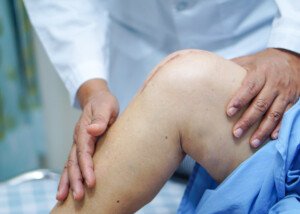 What could be the reason your knee is suddenly swollen and oddly painless, but there’s been no acute trauma like twisting it or falling on it?
What could be the reason your knee is suddenly swollen and oddly painless, but there’s been no acute trauma like twisting it or falling on it?
A sprained or torn ligament in a knee will result in swelling AND pain.
Getting hit in the knee can result in pain but not necessarily swelling.
But a little swelling with NO pain? Now that is odd.
If your knee is swollen but there’s no pain, this doesn’t mean it won’t feel strange.
The mild swelling, which is fluid, will make the knee feel a bit funny or “full.” This will become most apparent when you’re walking up or down stairs, and when you bend the knee.
It may feel like there’s a bandage wrapped around it when you bend it, yet there may not be any pain.
Mildly Swollen but Painless Knee: Possible Cause
“The most common cause of non-traumatic knee swelling is a misalignment of the large tibia bone that comprises the lower part of the knee joint,” says Eugene Charles, DC, Diplomate of applied kinesiology and author of “Journey to Healing: The Art and Science of Applied Kinesiology.”
“This frequently happens insidiously through daily activities where you turn your leg and foot out repetitively.
“These subtle movements include getting out of a chair or car seat and going up stairs.
“Over time the tibia bone rotates slightly out of alignment and needs to be realigned through a precise chiropractic or osteopathic adjustment.
“Resting it only helps because you are not using it, but rest alone does not fix the underlying cause of the knee problem — specifically the misalignment of the knee joint itself.”
What about a petallar tracking problem?
The patella is the kneecap. Women are more likely than men to experience a tracking issue with the patella, which can lead to pain, a feeling of fullness in the knee, and swelling.

But sometimes there may only be the funny feeling and the swelling.
Dr. Charles explains, “In over 33 years in practice, predominantly a sports injury practice, I have found that most patella tracking problems occur due to a rotated tibia bone which alters the movement (tracking) of the patella.
“Turning your leg and foot outwards when exercising, especially during leg extensions or lunges, are a common cause.
“It can also be due to a weakness of the medial quadricep muscle, relative to the outer quadriceps.”
Another Cause
If you think that your strange symptom was brought on by certain exercises, you should abandon those exercises for a while and see what happens.
Carrying excess body weight, in combination with high impact exercise such as jumping, or vigorous squatting, might aggravate the knee joint.
The knee joint is actually the most unstable joint in the body.
A weight reduction of just 10 percent can make a significant difference.
Lay off the suspected offending activity for a few weeks, ice it, and then as it begins to feel better, you can gradually return to your exercises – hopefully a few pounds lighter too.










































